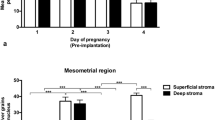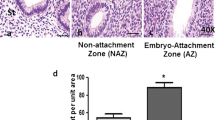Summary
The binding of 20 fluorescein isothiocyanate (FITC)-labeled lectins to various portions of the pregnant and non-pregnant murine oviduct and uterus was studied by fluorescence microscopy. Five lectins (from Ricinus communis (RCA-I), Maclura pomifera (MPA), Triticum vulgare (wheat germ-WGA), Bauhinia purpurea (BPA), and Ulex europeus (UEA-I)) reacted differentially with the epithelium of pregnant as compared with the non-pregnant uterus. The binding of RCA-I, MPA and WGA delineated pregnancy-related changes in the distal oviduct and colliculus tubaris. WGA recognized also pregnancy related changes in the proximal oviduct. The reactivity of the remaining 15 lectins did not distinguish the pregnant and non-pregnant oviduct and uterus, although some of them served to identify specific components of the mouse genital tract. Thus, Soybean lectin (SBA) reacted almost exclusively with the colliculus tubaris. UEA-I alone reacted exclusively with the epithelium of the non-pregnant uterus. RCA-II reacted preferentially with the epithelium of the oviduct and uterus as compared with its weak reactivity with the stroma. Two lectins (from Pisum sativum and Lens culinaris) reacted selectively with stromal cells of the uterus and oviduct. Present data indicate that the differential binding properties of these FITC-labeled lectins can be exploited to identify certain components of the mouse oviduct and uterus and to indicate changes in the cell surface and/or cytoplasm in these structures during pregnancy.
Similar content being viewed by others
References
Cooper HS (1982) Peanut lectin-binding sites in large bowel carcinoma. Lab Invest 47:383–388
Fowlkes BJ, Waxdal MJ, Sharrow SO, Thomas CA, III, Asofsky R, and Mathleson BJ (1980) Differential binding of fluorescein-labeled lectins to mouse thymocytes: subsets revealed by flow microfluorimetry. J Immunol 125:623–626
Goldstein IJ, Hayes CC (1978) The lectins: Carbohydrate-binding proteins. Adv Carbohydr Chem Biochem 35:127–340
Hafez ESE (1970) Female reproductive organs. In: Hafez ESE (ed) Reproduction and breeding techniques for laboratory animals. Lea and Febiger, Philadelphia, pp 74–106
Holthöfer H (1983) Lectin binding sites on kidney: A comparitive study of 14 animal species. J Histochem Cytochem 31:531–537
Hsu S-M, Ree HJ (1983) Histochemical studies on lectin binding in reactive lymphoid tissues. J Histochem Cytochem 31:538–546
Miettinen M, Holhöfer H, Lehto V-P, Miettinen A, Virtanen I (1983) Ulex europeus I lectin as a marker for tumors derived from endothelial cells. Am J Clin Pathol 79:32–36
Ree HJ, Hsu S-M (1983) Lectin histochemistry of malignant tumors. I. Peanut agglutinin (PNA) receptors in follicular lymphoma and follicular hyperplasia: An immunohistochemical study. Cancer 51:1631–1638
Watanabe M, Muramatsu T, Shirane H, Ugai K (1981) Discrete distribution of binding sites for Dolichos biflorus agglutinin (DBA) and for peanut agglutinin (PNA) in mouse organ tissues. J Histochem Cytochem 29:779–790
Wu T-C, Wan Y-J, Damjanov I (1983) Distribution of Bandeiraea simplicifolia lectin binding sites in the genital organs of female and male mice. Histochemistry 77:233–241
Author information
Authors and Affiliations
Rights and permissions
About this article
Cite this article
Lee, M.C., Wu, T.C., Wan, Y.J. et al. Pregnancy-Related changes in the mouse oviduct and uterus revealed by differential binding of fluoresceinated lectins. Histochemistry 79, 365–375 (1983). https://doi.org/10.1007/BF00491772
Accepted:
Issue Date:
DOI: https://doi.org/10.1007/BF00491772




